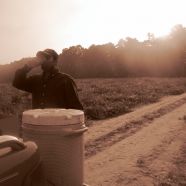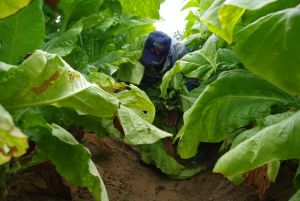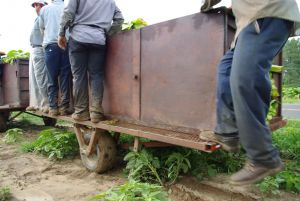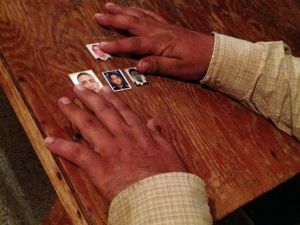
Photo courtesy of Student Action with Farmworkers. Drink by Beatriz Cruz and Yesenia Leon.
Share This
Print This
Email This
Connecting with Migrant Farmworkers in Rural Communities
It’s been nearly ten years since my brief encounter with a migrant farmworker in rural North Carolina tobacco country and there is something about the man I can instantly recall. It was not his age that carries the weight of this memory, even though it surprised me. He was seventy years old with a bent but strong build that could carry out the rigorous farm tasks that are hard on a body decades younger. His eyes twinkled and shone softly against toughened skin. It wasn’t the house either, with its slumping wooden frame, its ragged furniture and empty walls—a borrowed place in which to sleep and eat, nothing more. There was something else about him that I now remember most—his aloneness.
I sensed it instantly when my research partner and I stepped across the threshold; his solitude was enveloped in the kind of quiet that feels like the absence of someone, or something. There were other kinds of quiet, too—the exhausted quiet that follows a long day of back-breaking work, and the countryside quiet that one notices only after having lived in the city for too long. But it wasn’t until our visit was over, after this man kindly shared details of his life in his native Spanish and then wished us well with a wave from the porch as we drove away, that I realized just how alone he was in this world.
For decades, he had been traveling to the same rural corner of North Carolina from Mexico, spending several months each year working and living with other H2A or “guest worker” visa holders hired by U.S. growers to plant and harvest tobacco and other hand-labor crops. The year I met him, he had arrived at the start of the growing season with just one other worker—his nephew, who had fortuitously been assigned to the same farm. But a couple of weeks into the job, the younger man declared the work too difficult and the pay too little, and he broke the contract and left. His uncle stayed. The boss said a replacement for the nephew was coming, but so far no one had come. Working long days in the sun without anyone to talk to takes a toll, the elderly farmworker told me as he gazed distantly out the window to the yellowing rows upon rows of tobacco. I thought about the recent strand of heat-related deaths in North Carolina fields I’d read about. Healthy, adult men would become dehydrated and disoriented, and with no one to assist them, would wander off to find some kind of shade, lie down, and never wake up.
He had other concerns to share with us, but he spoke about them like minor nuisances, harmless flies to swat away. Like the chemicals they spray on the plants, he said, he suspected they did harm to his body after so much direct contact over the years, but didn’t feel there was anything he could say or do about it. Or having to ask the farm owner’s permission each time he wanted to call his family back home; the only telephone on the property he had access to was located in the garage of the boss’s house, a few minutes’ walk from the house where the workers stay, and he had to use phone cards he bought in town to dial out. He had no transportation of his own; the occasional grocery errand was provided by the boss. What was the nearest town? Where was the closest hospital? He didn’t know.
There was no complaining about these circumstances, this isolation. In fact, there was an almost cheerful sense of dignity and pride in his tone when he described his work. But there was no doubt about it—that farm was not where he wanted to be. Some questions seeded themselves that day that linger with me still: What does it feel like to spend half your life working someone else’s land for someone else’s profit, planting, tending, harvesting, and watching the sun rise and set on it? To live in a place for so long that has no resemblance of home—not the language, culture, climate, not even the simple daily rituals so many take for granted, such as going to the store or calling a friend? To grow older while a thousand miles away your children grow up and have children of their own?
After that visit, I kept asking questions like these. Gradually through that process, some childhood memories began to surface. When I was growing up, my parents asked similar questions about the circumstances for migrants in their community and they worked to make a difference. My dad was a Presbyterian minister and my mom a nurse practitioner, and the values they modeled for their five kids included treating everyone with respect and equality. They challenged my siblings and me to speak up against unfairness and injustice in our midst. In fact, it seemed they were always stirring up trouble wherever we went.
In the early ’80s we lived in a small town in Virginia, the kind of place where you’ll find a Civil War marker and a church on every corner. When my parents and a few other community members learned of several Haitian families who had migrated to the area to work on apple orchards, they solicited help from the Virginia Council of Churches and the regional Migrant Head Start program to start a daycare center. There was no place the moms and dads could send their young children while they worked, so they would either bring them to the orchards or leave them at the labor camp, which was described to me as a cluster of small cinder-block dwellings that trapped the summer heat, the only source of running water a communal spigot in the courtyard. Hazy memories tell me that as a toddler I was often surrounded by other children who did not look or sound like me, and this is perhaps because the daycare center was formed in the living room of my family’s home, where my two younger siblings and I were also cared for. After a few months, when it became evident that this was not enough space to accommodate the need, my parents turned to the church where my father served as pastor with the prospect of moving the daycare center there. Some congregation members were unnerved by the idea and it was a hard-fought battle, but eventually the church opened its doors. I can only speculate what lay at the root of this resistance. An anti-immigrant sentiment interlocked with racism? Or was it simply a reluctance to share a sacred space with strangers, even though the strangers were young children, and furthermore the children of the men and women who worked the land just beyond the church walls to help bring profit to the region and food to our tables?
No matter what fueled the discrimination toward the migrant families in my hometown back then, I quickly came to see evidence of its existence all around me, in both past and present. Before I was born, my dad was involved as an organizer in the early years of the famous grape boycott, when he chaired the United Farm Workers Support Committee of Palm Beach County, Florida. Sometimes he would tell us kids about the poverty in the labor camps, the unfair wages and working conditions, and I could hear the enduring indignation in his voice even though years had passed since his direct involvement. My mom was equally passionate about these issues but took a different approach. When our family lived in Michigan, she worked as an outreach nurse for a community health center and visited Mexican families in their homes who had moved to the area to work the berry crops. Some afternoons when I got out of school, I accompanied her on her visits to mobile homes to do health assessments, administer vaccinations, and deliver medicines. Even though we never drove far I remember thinking in my eleven-year-old mind that the trailers appeared to have been dropped from the sky to land in the middle of a vast nowhere.
Nearly twenty years after those visits to labor camps with my mom, I found myself driving down unmarked country roads in North Carolina—the state I now call home—to locate farmworkers in need of health services. It would be reasonable to think my journey up to that point was a straight shot launched years ago by my parents’ influence. However, I never envisioned or planned for a job focused on the issues surrounding migrant labor that were so much a part of my childhood, maybe because I assumed that the working and living conditions that existed then would be improved by the time I started my career. It was a needs assessment project during graduate school in social work that led me to the doorstep of the seventy-year-old tobacco worker. My task was to accompany a colleague to interview farmworkers in parts of the state that lacked targeted health outreach services. We visited places that evoked scenes from the 1960 CBS special “Harvest of Shame” by Edward R. Murrow about the plight of migrant workers in the United States as well as scenes from the labor camps my parents had visited in the ’70s and ’80s. Soon I would see similar conditions and health concerns in farming communities everywhere, not just areas lacking a migrant health clinic.
At some point during my interviews with farmworkers, I became certain that it was only the beginning of the work I wanted to dedicate myself to in my adult life. It was a combination of influences that formed this certainty: the shock at seeing how little the conditions had changed, the enjoyment of conversing with someone from another culture and background than my own, the respect for the type of labor and commitment involved in tending the land, and the inspiration my parents’ actions had sparked in me. I admit that it may have been driven, as well, by the interview with the elderly tobacco worker and how it touched something embedded in my private history: a desire to reach out to find the ties of humanity—however frayed or tenuous—that connect people, regardless of where our roots are.
My roots are in the South, proudly, but they don’t run deep. We moved around a lot when I was younger, attributed mostly to my dad’s knack for speaking his mind from the pulpit. He was beloved by most parishioners but his rallying for peace and justice did not sit well with everyone in the pews. Perhaps feeling like an outsider for much of my childhood motivates me to reach out to others who might feel the same. I will not compare my childhood struggles with those of migrant families that I am only peripherally familiar with; numerous factors that are not a part of my reality—such as socioeconomic differences; discrimination based on ethnicity, culture, and language; trauma related to war and migration; and far too many others—compound the experiences of many agricultural workers living in the margins of our society. But I honor that part of me that yearns for community through the connections I have been lucky to form with farmworker families, health outreach workers, and advocates for worker justice. It is the part of me that wants to stay an hour longer talking with the elderly tobacco worker in his quiet, empty house, and the part of me that wants to talk about the unspoken irony that forms the backbone of our agricultural system: That those who work the land are not given a seat at the table or the freedom to make their own decisions. That too often they live in communities but are not acknowledged as a part of them.
Note: There are an estimated 150,000 migrant and seasonal farmworkers and their families living in North Carolina each year. They are men, women, and children. Some live year-round in North Carolina while others follow the migrant streams to work America’s crops, approximately 85 percent of which are harvested by hand. Some farmworkers hired through permits leave their families behind in their home countries, arriving by bus and then being sent to a farm for the season in a place they may know well or may have never heard of. They live in remote barracks-style camps, farmhouses, trailers, or old motels. Homes may be too crowded, or in the case of the man I met long ago, too empty, but it’s important to note there is a wide range of living and working conditions that can vary by employer, crop, and region. Farmworkers, farmworker allies, and some farm employers in North Carolina and across the United States have long recognized the need for outreach to the camps, support for worker empowerment and leadership, and changes in legislation that would raise the standards for working and living conditions and ensure better enforcement of existing worker protections.










I represent the Justice in Agriculture Committee of the Episcopal Diocese of NC. We also have concern for the migrant communities of our state. H2a camps are abundant throughout the rural parts of our state and can readily be identified through a data base maintained by the NC Dept. of Labor. H2a workers live an existence that is reminiscent of slavery. Find a Camp near you and care for your brother.